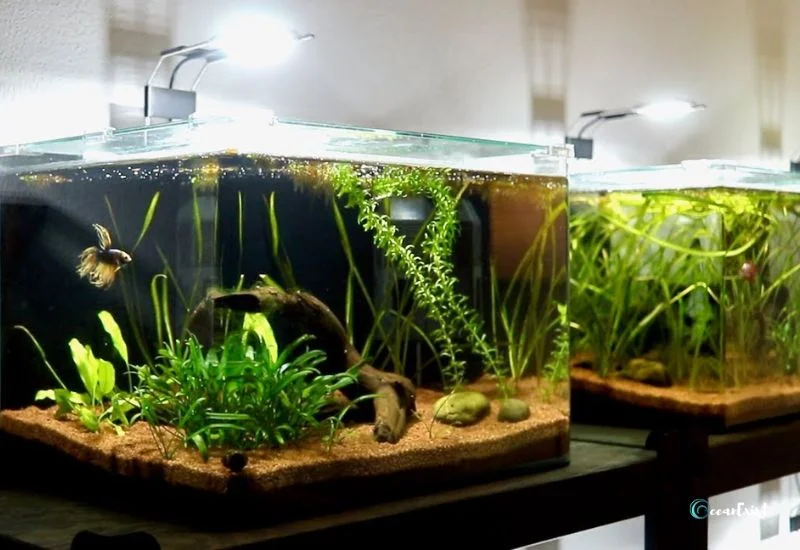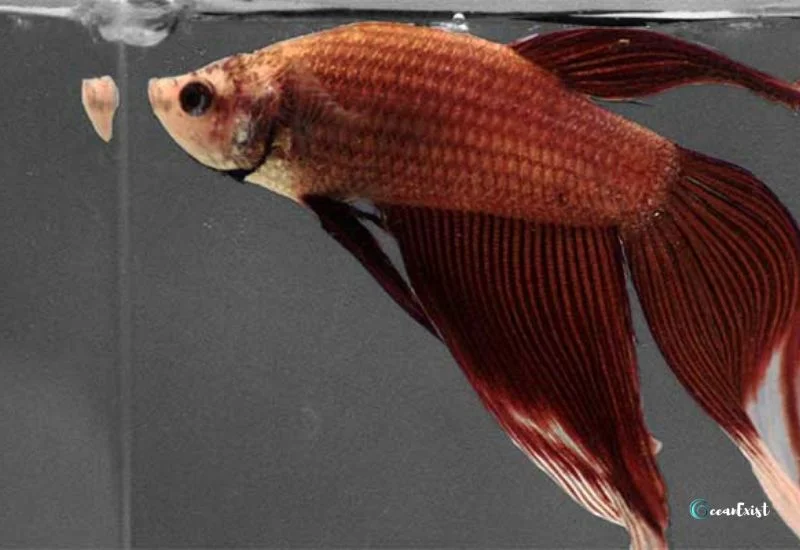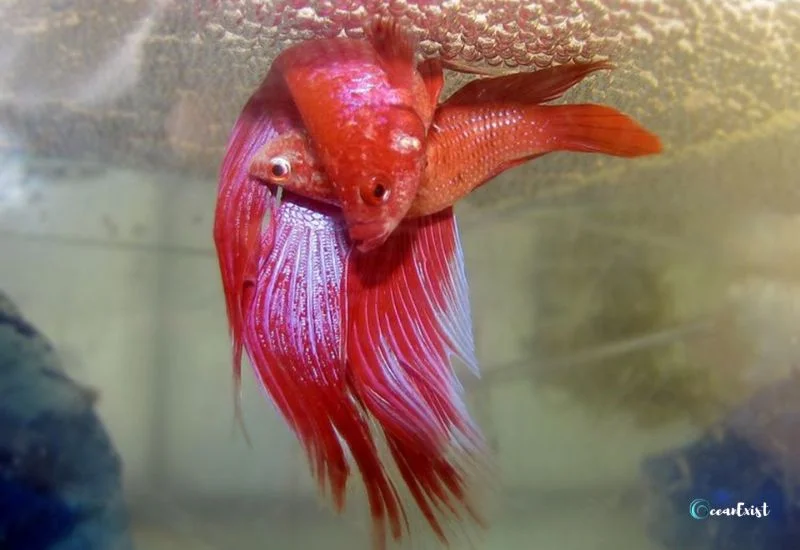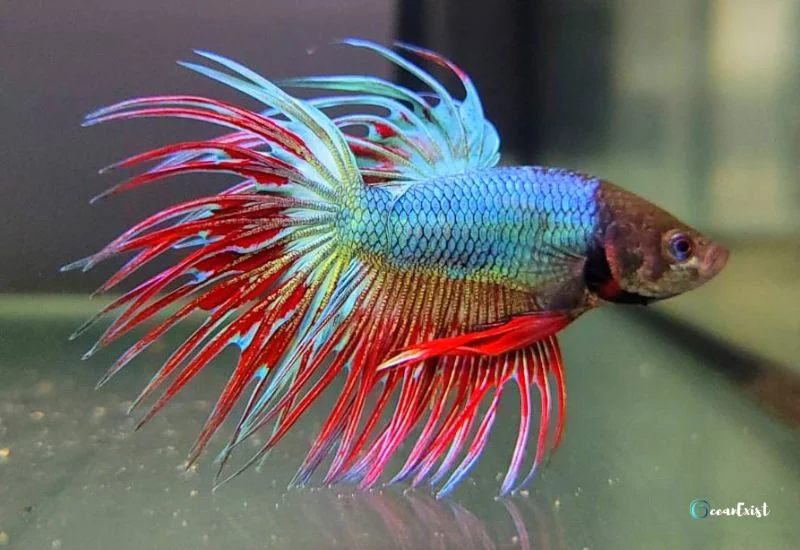The Crowntail Betta is a freshwater tropical fish. They have a spectacular tail design, vivid colors, and striking patterns on their body, amusing the aquarists with their look.
Delve deeply into this article to explore the vivid beauty of Crowntail Betta fish, their food, dietary requirements, and other requirements for housing them in your aquarium.
They are commonly available in all pet stores, where they are simply known as ‘Bettas’ or ‘Betta splendens.’
Appearance of Crowntail Betta Fish
They have flat gills against their body just below the head. The Crowntail fish are very territorial, and when they feel unsafe or frightened, their gills start flaring in the water.
Their caudal fins are dramatically elongated and significantly longer than those of other Betta varieties. This ornate design of Crowntail betta fish mimics a king’s crown, which has been named Crowntail Betta.
The Crowntail can grow from 2.5 to 3 inches in size. They have a very small lifespan of 3 years. But, if you feed them high protein and nutritious food, it can increase up to 5 years.
The male Crowntail Bettas have long fins, while fins in females are slightly shorter than males. You might see splashes of neon blue, red, violet, or shimmering green color on their body.
Crowntail Betta Care

Crowntail Betta care is not easy. You have to be extra careful when housing these fish. They have different diet plans and different tank requirements, and you have to be selective when making tank mates for them.
Here are the things you need to take into account with respect to care requirements for Crowntail betta fish.
Tank Requirements for Crowntail Betta Fish
The Crowntail Bettas require a larger tank of a minimum of 5 gallons of capacity. These fish love to swim around and explore the aquarium to keep themselves refreshed.
These Bettas are very sensitive to deteriorating water conditions. They require fresh water for their physical well-being. This freshwater also keeps their fins active.
So, keep changing the water frequently, properly filter the water, and add necessary chemicals like ammonia.
These Bettas are fond of swimming deep in the water. A shallow and spacious tank is ideal for housing Bettas in a captive environment.
Water Parameters
Crowntail betta fish belong to the shallow water of Southeast Asia. They live in bushy and gloomy areas down in the water.
Like any other fish, You can maintain suitable water conditions for Crowntail Bettas by imitating their natural habitat.
The Crowntail Bettas will thrive better in a captive environment If they are provided with the optimum temperature, moderate pH, and water hardness.
Any imbalance in these water conditions may prove harmful and fatal for your Bettas. So, keep checking the water temperature, water pH, and necessary chemicals like ammonia and nitrate proportions in the water.
Here is a list of water parameters requirements:
- Water temperature in the range of 76°F-80°F.
- Water hardness level from 2-5 dKH.
- Water pH levels range from 6.4 to 7.0.
Aquarium Heater
Some people use heater mats in the small aquariums. Meanwhile, aquarium heaters and thermometers are used to maintain the temperature of bigger aquariums.
The Crowntail Betta fish are warm-water fish from tropical areas. An aquarium heater will be required, especially in winter seasons.
Aquarium Lighting
The Crowntail Bettas are inhabitants of tropical areas where sunlight always remains in the water. You can imitate this by installing a small lightbulb over the aquarium.
Crowntail Betta Food and Diet

The Crowntail Bettas diet plan is not very complex. They have very small stomachs which fill up quickly. So, avoid overfeeding because it may cause constipation and other health problems in them.
Feeding them food in small quantities 2-3 times a day is considered ideal. They are omnivorous and can eat both vegetables and meat. But, you should balance their food by including some high-rich and more nutritious food in their regular diet plan.
Their food consists of small insects, brine shrimps, bloodworms, and live or frozen fish food. Make sure that the given food does not float for a long time in the aquarium to maintain the water quality.
Crowntail Betta Tank Mates
The Crowntail Bettas are very fierce, especially with their own species of fish and other species that have the same appearance and size. They must be kept in a separate aquarium due to their aggressive nature. You must avoid housing them with fin-nipping fish.
However, there are some suitable Crowntail Tankmates mentioned in the list below. But, If you see any aggressive nature or fight in the tank, separate out Crowntail Betta.
- Ghost Shrimps
- Fast moving Guppies
- Neon Tetra
- Corydoras Catfish
Alert: Do not forget that your Crowntail Betta needs a lot of tank space. So, always bring tank mates if you have a big aquarium.
Breeding in Crowntail Betta

The Crowntail Betta breeding is not recommended for beginner aquarists. It involves the understanding of all ongoing breeding processes.
- First of all, You must have a large tank to provide the Betta enough space for breeding.
- Second, they must be fed high-protein food for breeding.
- Third, keep the aquarium temperature high.
Like many fish species, male Bettas fascinate the female with their dance for breeding. Then, the male Bettas blows the bubble nest in the water, and if the female is receptive, she allows it to wrap around her.
The female releases the eggs, which the male collects and fertilizes in the nest. This is a protective balloon for the Bettas. Male Betta protects the eggs from other fish and from the female Betta, too. You can separate the female from the aquarium.
Now, in the next 24-48 hours, eggs will be hatched. They can live on egg sacs for the next few days. When they are able to swim freely in the aquarium, you can feed them micro-foods like infusoria.
Potential Challenges For Keeping Crowntail Bettas
- An imbalance in any water parameters can be harmful to the Crowntail Bettas. Always keep fresh water in the aquarium and balance the aquarium’s pH and temperature.
- The Crowntails Bettas are very aggressive and are not considered community aquarium members. Always be careful while choosing tank mates with the Crowntail Bettas.
Conclusion
In conclusion, Crowntail Bettas are very charming, vivid, colored fish with beautiful tails and fins flaring in the water. Now, You have all the information about Crowntail Betta care, diet plan, tank requirements, and tank mates. So, If you have any query related to Crowntail Bettas, You can ask in the comments.
